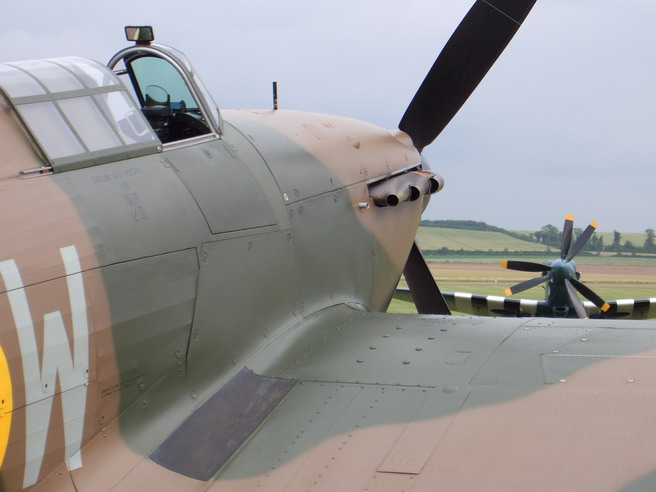


Hawker
HURRICANE Mk I
have a look
|
The Hurricane was the first monoplane fighter produced by Hawker, and was available in substantial numbers at the beginning of World War II. Hurricanes played a decisive role in the Battle of Britain when it equipped 26 RAF and 1 RCAF squadrons, and went on to fly on more fronts than any other British fighter. The Hurricane also earned distinction for being the most versatile of single seat warplanes to emerge from the Second World War. Later in the war, Sea Hurricanes were launched by catapult from ships at sea to defend convoys against air attack. A "tank buster" version with 40mm cannon was used in North Africa.
The initial production Hurricane I entered RAF service in December 1937, with 111 RAF Squadron. Powered by the famous Rolls-Royce Merlin engine, it became the first RAF monoplane fighter with an enclosed cockpit and retractable undercarriage, its first fighter capable of a level speed in excess of 300 mph (483 km/h), and its first eight-gun fighter. Squadrons were
rapidly equipped with the Hurricane, thanks to the foresight of the Hawker
Aircraft directors, and at the time war was declared, on 3 September,
1939, just short of 500 Hurricanes had been delivered and eighteen
squadrons had been equipped. These were all of the Mark I type, armed with
eight 0.303-in. machine-guns but having alternative propeller
installations: a Merlin II engine driving a Watts two-blade fixed-pitch
wooden propeller, or a Merlin III of similar power having a standardized
shaft for de Havilland or Rotol three-blade metal propellers.
Hurricane Mk I of 601 Squadron Royal Air Force - Battle of Britain 1940 When it became clear that the Hurricane was becoming outclassed as a pure fighter, other duties were assigned to it. In October 1941 the 'Hurribomber' fighter-bomber came into being, carrying either two 250lb (113 kg) or two 500lb (226 kg) bombs under its wings. The Mk IID of 1942 was fitted with two 40 mm cannon for tank busting and two machine guns, and was operated mainly in North Africa against Rommel's desert forces and in Burma against the Japanese. Other Hurricanes carried rocket projectiles as alternative ground attack weapons. The year 1943 saw two important developments in the Hurricanes history--the introduction of the Mark IV and the adoption of the Hurricane to fire rocket missiles or, as they were initially known, "unrifled projectiles". The Hurricane IV used a Merlin 24 or 27 which developed 1,620 hp for take-off, and it featured "low attack" or universal armament wings. These wings were derived from those fitted to the Hurricane IID and could carry the 40-mm. Vickers or Rolls Royce cannon, bombs, drop-tanks or rocket projectiles. The Hurricane IV was operational in the Middle and Far East theatres until the end of the war, and in Europe until the end of 1944.
The
SPECIFICATIONS
PERFORMANCE Source & courtesy of: http://www.wpafb.af.mil/museum/early_years/ey15a.htm
Acknowledgments
The page of Fleet Air Arm Archive |